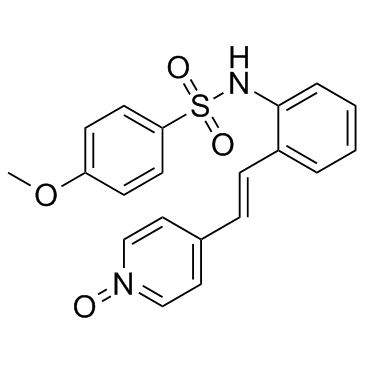| Description |
HMN-176 is a stilbene derivative which inhibits mitosis, interfering with polo-like kinase-1 (plk1), without significant effect on tubulin polymerization.
|
| Related Catalog |
|
| Target |
PKL1[5]
|
| In Vitro |
HMN-176 (2.5 μM) greatly increases the duration of mitosis in hTERT-RPE1 and CFPAC-1 Cell lines. The effect of HMN-176 on spindle morphology does not appear to be related to effects on microtubule polymerization. HMN-176 (2.5, 0.25, and 0.025 μM) inhibits aster formation in a concentration dependent manner[1]. HMN-176 (0.1, 1.0, or 10.0 µg/mL) demonstrates inhibitory effects in multiple tumors, with notable activity seen in breast, nonsmall-cell lung, and ovarian cancer specimens. HMN-176 demonstrates activity towards 63% of the breast (5/8), 67% of the non-small cell lung (4/6), and 57% of the ovarian (4/7) tumor specimens treated with 10.0 µg/mL[2]. HMN-176 shows potent cytotoxicity, with a mean IC50 value of 118 nM. HMN-176 displays similar cytotoxicity against tumors with various characteristics from different organs[3]. Treatment with 3 μM HMN-176 suppresses the expression of MDR1 mRNA by 56%. HMN-176 has no significant effect on the residual promoter activity[4].
|
| In Vivo |
HMN-176 prevents spindle assembly and meiosis in Spisula oocytes by inhibiting centrosome-dependent MT nucleation, i.e., aster formation. Oocytes treated with 0.25 μM HMN-176 undergoes GVBD, but asters or spindles fails to form, even after prolonged periods[1]. After p.o. of HMN-214 to male rats, the prodrug is not detected in the plasma, while plasma levels of HMN-176 peaks at 2 h and gradually decreases thereafter[3].
|
| Cell Assay |
Cells to be tested are seeded into a 96-well microplate at a density of 3 ×103-1×104 cells/well. Drugs are added the next day and the plate is incubated for 72 h at 37 °C in a humidified incubator (5% CO2, 95% air). The inhibition of growth is measuredby the MTT assay, and the concentration required to produce 50% inhibition of growth (IC50) calculated by the Scansoft 96 software program. The IC50 values for HMN-176 andreference agents are presented. Briefly, for each compound the mean IC50 value for all cell lines tested is calculated and the difference between the individual IC50 values and the mean IC50 value (log10) displayed by a bar projecting to the right or left of the mean. The resistance index is calculated as (IC50 value for drug-resistant cell line)/(IC50 for parent cell line).
|
| Animal Admin |
14C-HMN-214 and 14C-HMN176 are p.o. to male SD rats at doses of 33 (equivalent to 30 mg/kg of HMN-176) and 30 mg/kg, respectively. Blood samples are collected at designated times and plasma levels of radioactivity determined with a liquid-scintillation counter. In addition, unlabeled HMN-214 (33 mg/kg) is administered to male rats and plasma concentrations of HMN-214 and HMN-176 are determined by high performance liquid chromatography.
|
| References |
[1]. DiMaio MA, et al. The small organic compound HMN-176 delays satisfaction of the spindle assembly checkpoint by inhibiting centrosome-dependent microtubule nucleation. Mol Cancer Ther. 2009 Mar;8(3):592-601. [2]. Medina-Gundrum L, et al. Investigation of HMN-176 anticancer activity in human tumor specimens in vitro and the effects of HMN-176 on differential gene expression. Invest New Drugs. 2005 Jan;23(1):3-9. [3]. Takagi M, et al. In vivo antitumor activity of a novel sulfonamide, HMN-214, against human tumor xenografts in mice and the spectrum of cytotoxicity of its active metabolite, HMN-176. Invest New Drugs. 2003 Nov;21(4):387-99. [4]. Tanaka H, et al. HMN-176, an active metabolite of the synthetic antitumor agent HMN-214, restores chemosensitivity to multidrug-resistant cells by targeting the transcription factor NF-Y. Cancer Res. 2003 Oct 15;63(20):6942-7. [5]. Garland LL, et al. A phase I pharmacokinetic study of HMN-214, a novel oral stilbene derivative with polo-like kinase-1-interacting properties, in patients with advanced solid tumors. Clin Cancer Res. 2006 Sep 1;12(17):5182-9.
|
